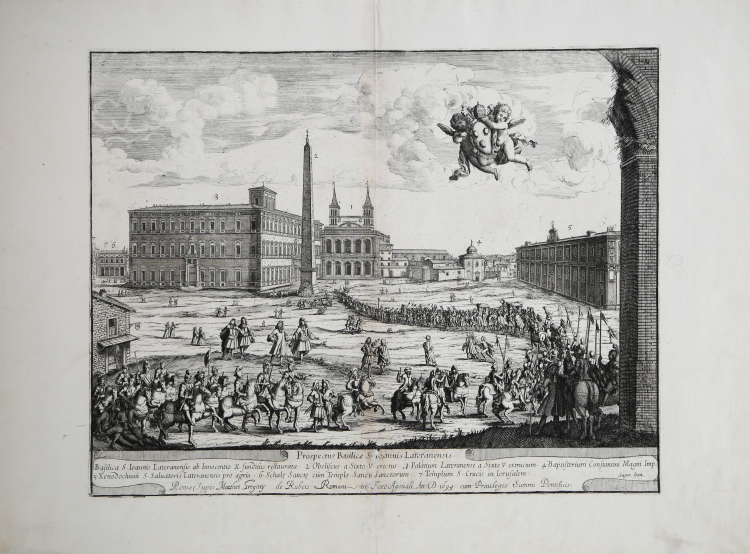




| Reference: | S46636 |
| Author | Lievin CRUYL |
| Year: | 1666 ca. |
| Zone: | San Giovanni in Laterano |
| Printed: | Rome |
| Measures: | 480 x 375 mm |



| Reference: | S46636 |
| Author | Lievin CRUYL |
| Year: | 1666 ca. |
| Zone: | San Giovanni in Laterano |
| Printed: | Rome |
| Measures: | 480 x 375 mm |
View of Piazza del Popolo engraved by Lievin Cruyl for publisher Giovanni Battista de Rossi in 1666.
Example in the second state of three, with the address of Matteo Gregorio de Rossi and the date 1693. In this edition the print is completely changed; the figures in the foreground and the entire set of the ancient wall are abraded. In their place is inserted a procession heading toward the Lateran. Two cherubs supporting the papal coat of arms of Innocent XII Pignatelli are added at the top right; almost as if to tell of the ceremony of Possession of the Pope, who had settled in 1691.
Cruyl starter drawing and engraving views when he moved to Rome around 1664. His first works were his twenty one drawings, once kept in the Albertina in Vienna and nowadays divided between the Cleveland Museum and Rijksmuseum.
The drawings actually are the counterpart of the subjects they depict for they were meant to be used for the realization of engravings.
Only ten of these subjects have actually been engraved by Cruyl and published for the first time in 1666 by Giovan Battista de Rossi in a volume dedicated to Pope Alexander VII, entitled Prospectus loco rum Urbis Romae Insignis; the collection was afterwards reissued by Matteo Gregorio de Rossi between 1692 and 1698. Cruyl characterized every single view by adding some figures which perfectly adhered to the urban context and, at the same time, he describes and defines the monuments of the city of Pope Alexander. To realized his aim, the artist changed the real perspective and modified the urban space.
Lievin Cruyl (1640-1720) Flemish draughtsman of perspective views, originally from Ghent, moved to Rome in 1644. Together with Giovan Battista Falda and Israel Silvestre, he was one of the renewers of Roman views in the 17th century. Although he was influenced by the 16th century conception of the role of antiquity in the image of Rome, he represented the urban architectural innovations of the Rome of Alexander VII (Fabio Chigi 1655- 1667), characterising his views with small genre scenes in the Flemish tradition. In the representation of urban space, Cruyl alters perspective, raising the viewpoint and dilating the field of vision, using the most advanced optical techniques of the time.
Etching, printed on contemporary laid paper, with full margins, minimal restorations to verso of vertical center fold, otherwise in excellent condition.
Bibliografia
B. Jatta, Lievin Cruyl e la sua opera grafica, p. 155/4S, figg. 48-49.
Lievin CRUYL (Ghendt 1640 - 1720)
|
Flemish priest, draughtsman and etcher, active also in Italy and France. While living in Wetteren (nr Ghent), he was involved in the completion of the Gothic St Michielskerk in Ghent. The construction of the western tower had been interrupted in 1566 because of religious unrest, and in 1652 steps were taken to complete it. After a Renaissance design was proposed in 1653, Cruyl submitted a drawing in Brabantine Late Gothic style (Ghent, Bib. Rijksuniv.) in 1662. His tower was to have been 134 m high, higher than the north tower of Antwerp Cathedral (1521). However, the project was never realized because of lack of funds. Although unoriginal and of an outdated style, the design had elegance and grandeur
|
Lievin CRUYL (Ghendt 1640 - 1720)
|
Flemish priest, draughtsman and etcher, active also in Italy and France. While living in Wetteren (nr Ghent), he was involved in the completion of the Gothic St Michielskerk in Ghent. The construction of the western tower had been interrupted in 1566 because of religious unrest, and in 1652 steps were taken to complete it. After a Renaissance design was proposed in 1653, Cruyl submitted a drawing in Brabantine Late Gothic style (Ghent, Bib. Rijksuniv.) in 1662. His tower was to have been 134 m high, higher than the north tower of Antwerp Cathedral (1521). However, the project was never realized because of lack of funds. Although unoriginal and of an outdated style, the design had elegance and grandeur
|